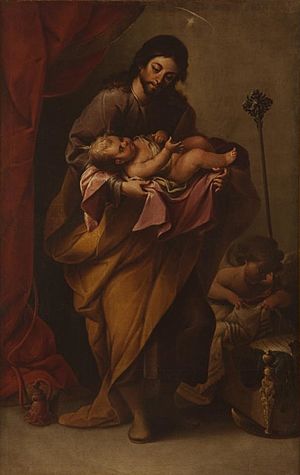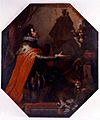Andrés Amaya facts for kids
Quick facts for kids
Andrés Amaya
|
|
|---|---|
| Born | c. 1645 Unknown
|
| Died | 29 October 1704 Valladolid, Spain
|
| Nationality | Spanish |
| Style | Baroque, religious art, oil painter |
| Spouse(s) | Isabel Lozano |
Andrés Amaya (born around 1645 – died October 29, 1704) was a Spanish painter. He was known for his religious paintings made with oil paints during the Baroque period. He worked mostly in the Castile and León region of Spain, especially in the city of Valladolid.
Biography
We don't know much about where Andrés Amaya came from or what his early life was like. One writer even said his life was "covered by an enormous mist," meaning it's very mysterious! His last name, Amaya, is linked to a small village called Amaya in Spain.
It's hard to know the exact order of his paintings because most of them don't have dates. He mainly painted religious scenes, but people say he also painted portraits (pictures of people). His artworks that still exist today are found in and around Valladolid.
A Spanish art historian named Juan Agustín Ceán Bermúdez thought Amaya was a student of Vicente Carducho. However, this isn't possible because Carducho died before Amaya was born. It's more likely that Amaya was influenced by other Spanish painters from his time, like Alonzo Cano.
We have very few records about Amaya's life. One record shows that in 1687, Amaya was a witness at a wedding in Valladolid.
Amaya was married to Isabel Lozano. They lived near a place called "Puerta del Campo" in Valladolid. Andrés Amaya passed away on October 29, 1704. A painter named Ignacio de Prado was his student. Amaya's wife thought very highly of Ignacio.
Works
Here are some of the artworks believed to be by Amaya:
- 1682 – Paintings for the main altar, Iglesia de San Martín, Segovia
- 1693 – St Francis and St Teresa, Iglesia Penitencial de la Vera Cruz, Valladolid
- Around 1667-1700 – The Virgin appearing to Fernando III the Saint, Museo Nacional de Escultura, Valladolid
- Last part of the 17th century – The Virgin appears to a Dominican in Soriano, Museo Nacional de Escultura, Valladolid
- Around 1693 – The Holy Family, Iglesia Penitencial de la Vera Cruz, Valladolid
- Around 1700 – St Joachim, Iglesia de San Pedro, Valladolid
- Date unknown – St Joseph with the Child, Valladolid Cathedral
- Date unknown – St Joseph with the Child, Museo Nacional de Escultura, Valladolid
- Date unknown – Series of paintings about the life of St John the Baptist, Basílica de San Isidoro, León
- Date unknown – Unknown subject, Iglesia de San Miguel, Palencia
- Date unknown – Unknown subject, San Millán de la Cogolla
- Date unknown – Unknown subject, Toro, Zamora
- Date unknown – Unknown subject, Villafranca del Bierzo
Gallery
See also
 In Spanish: Andrés Amaya para niños
In Spanish: Andrés Amaya para niños







